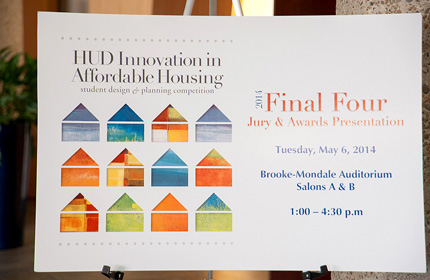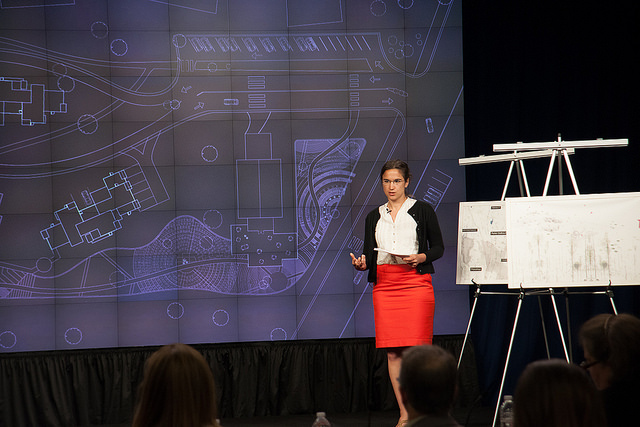
Innovation in Affordable Housing Student Design and Planning Competition: Ohio State Wins the Inaugural Year

After winning the inaugural IAH competition with their design to house homeless veterans, Ohio State University team members posed on stage with HUD Secretary Shaun Donovan. Photo courtesy of HUD photographer.
The 2014 HUD Innovation in Affordable Housing Student Design and Planning Competition (IAH) came to a close on May 6, 2014. This year’s competition was based on a housing project that is being pursued by HUD’s partner for IAH 2014, the Housing Authority of Bergen County (HABC). HABC’s project involves creating affordable housing for homeless veterans on a 1.5-acre site that includes the historic Peter DeBaun House, which had been used for many years as a meeting place for the local American Legion post. IAH student participants needed to create an all-encompassing plan that included design, community development, and financing elements that would allow HABC to build the affordable housing while preserving the historic building. The competitors also needed to take into account the needs of the intended residents, local zoning restrictions, and leveraging opportunities.
During the first phase of the competition, a jury of five practitioners, planners, and architects narrowed the submissions down to four finalist teams: New York University, University of Michigan, The Ohio State University, and a joint New York University/Columbia University team. On March 26, 2014, the finalists traveled to a frigid and blustery Emerson, New Jersey, to visit the project site. The site visit provided students with a valuable opportunity to walk through the site, study its topography, and see the surrounding neighborhood. The students were then given an opportunity to further refine their plans based on the site visit and the jurors’ comments before the final event.

On May 6, 2014, each of the four finalist teams presented their designs and answered questions from a panel of jurors. Photo courtesy of HUD photographer.
On May 6, 2014, the four finalist teams presented their ideas in front of a panel of jurors at HUD Headquarters in Washington, DC. HUD staff members and interested members of the public attended the event, with many others nationwide viewing it via webcast. Each student team devoted 20 minutes to its presentation and then spent 10 minutes answering questions from the jury.
All of the student finalists submitted innovative and intelligent plans for the project site, making the jurors’ task of choosing a winner and a runner-up a difficult one. Secretary Donovan, who announced the winners, emphasized this point in his remarks, noting that the students demonstrated that they could “make a real and meaningful difference in the here and now.”
The runner-up team, which received a $5,000 prize, was the joint team from New York University and Columbia University. The team’s plan included three buildings with eight units each and featured innovative ideas such as a grey/black water system, a transportation center for residents, and a multi-season gazebo. The DeBaun House would serve as an educational and community space, with a special emphasis placed on the building’s rich history. An outdoor café would sell products from a resident-maintained garden, supplying both residents and the community with fresh and healthy food.

Anna Lauren Oursler of Columbia University presented the team’s design for the HABC site, which included a multi-season gazebo and a grey/black water system. Photo courtesy of HUD photographer.
The Ohio State University’s team took home the grand prize of $10,000. The team’s design included four buildings with six units each, a main circulation core between buildings, and common areas such as a south garden and a north patio. The team also outlined an effective outreach plan and discussed the seven elements of wellness throughout their presentation. Redevelopment of the DeBaun House would add a partitioned community meeting room, a gym, and open office space for two social workers and a coordinator.
After announcing the results and taking pictures with the winning teams, Secretary Donovan encouraged the students and all attendees to keep the important work on affordable housing moving forward and challenged everyone to keep looking for innovative ways to ensure that every American can gain access to a quality, affordable home. In this spirit, the planning is already underway for next year’s IAH, which will launch in the fall of 2014.
PD&R Leadership Message Archive
International & Philanthropic Spotlight Archive
Spotlight on PD&R Data Archive
Publications
Collecting, Analyzing, and Publicizing Data on Housing Turnover
Resilience Planning: What Communities Can Do to Keep Hazards from Turning into Disasters
Cityscape: Volume 26, Number 3
Case Studies
Case Study: Former School in Charleston, South Carolina, Transformed into Affordable Housing for Seniors
Case Study: Avalon Villas Combines Affordable Housing and Services for Families in a Gentrifying Phoenix Neighborhood

The contents of this article are the views of the author(s) and do not necessarily reflect the views or policies of the U.S. Department of Housing and Urban Development or the U.S. Government.
Note: Guidance documents, except when based on statutory or regulatory authority or law, do not have the force and effect of law and are not meant to bind the public in any way. Guidance documents are intended only to provide clarity to the public regarding existing requirements under the law or agency policies.



